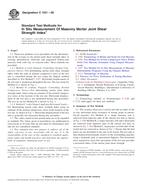Potřebujeme váš souhlas k využití jednotlivých dat, aby se vám mimo jiné mohly ukazovat informace týkající se vašich zájmů. Souhlas udělíte kliknutím na tlačítko „OK“.
ASTM C1531-09
Standard Test Methods for In Situ Measurement Of Masonry Mortar Joint Shear Strength Index
Automaticky přeložený název:
Standardní zkušební metody pro in situ měření zdící malty Joint smykové pevnosti Index
NORMA vydána dne 1.6.2009
Informace o normě:
Označení normy: ASTM C1531-09
Poznámka: NEPLATNÁ
Datum vydání normy: 1.6.2009
Kód zboží: NS-11730
Počet stran: 7
Přibližná hmotnost: 21 g (0.05 liber)
Země: Americká technická norma
Kategorie: Technické normy ASTM
Anotace textu normy ASTM C1531-09 :
Keywords:
coefficient of friction, flatjack, in situ, masonry, mortar joint, nondestructive evaluation, shear strength, Coefficient of friction (COF), Flatjack method, In-situ inspection/analysis, Joint strength, Masonry mortar, Nondestructive evaluation (NDE), Shear testing--building materials, ICS Number Code 91.080.30 (Masonry)
Doplňující informace
| Significance and Use | ||||||||||||||
|
The masonry mortar joint shear strength index obtained by this test method is related to the masonry wall shear strength by a relationship contained within Appendix Chapter 1 of the Uniform Code for Building Conservation. The user of this standard is cautioned that the shear strength relationship contained within the Uniform Code for Building Conservation is an empirical relationship based on tests of early 20th-century unreinforced brick masonry. The relationship assumes that wall shear strength is limited by shear of the mortar joints rather than shear through the units. For hollow ungrouted or solid unit masonry construction the shear strength index is measured only for the mortar bed joints vertically adjacent to the unit being tested. When testing hollow ungrouted masonry construction, the shear strength index is based on the horizontal interface between the mortar and the test unit and the masonry above and below the test unit. In the case of multi-wythe construction, the measured mortar joint shear strength index is applicable only to the wythe in which the test unit is located; no headers shall exist immediately above or below the test unit. The contribution of any existing collar joint mortar to the measured shear strength index is neglected, and this may lead to an overestimate of the shear strength index. The test procedure listed for Method A may be conducted as an extension of Test Method C 1197. The two-flatjack test, conducted in accordance with Test Method C 1197, provides half of the required test setup for Method A. At the completion of the Method A test, one would know the measured normal compressive stress, the deformability of the masonry at the test, and the relationship between the expected joint shear strength index and the normal compressive stress. |
||||||||||||||
| 1. Scope | ||||||||||||||
|
1.1 These test methods cover procedures for the determination of the average in situ mortar joint shear strength index in existing unreinforced solid-unit and ungrouted hollow-unit masonry built with clay or concrete units. Three methods are provided: 1.1.1 Method A (with Flatjacks Controlling Normal Compressive Stress)—For determining mortar joint shear strength index when the state of normal compressive stress at the test site is controlled during the test using the flatjack method described in Test Method C 1197. Horizontal displacement of the test unit is monitored throughout the test. The test setup for Method A is shown in Fig. 1. 1.1.2 Method B (without Flatjacks Controlling Normal Compressive Stress)—For determining mortar joint shear strength index when using an estimate of the normal compressive stress at the location of the test site. Horizontal displacement of the test unit is not monitored during this procedure. The test set up for Method B is shown in Fig. 2. 1.1.3 Method C (with Flatjack Applying Horizontal Load)—For determining mortar joint shear strength index using an estimate of the normal compressive stress at the location of the test site, as shown in Fig. 3. Horizontal displacement of the test unit is generally not measured during this procedure. 1.2 The values stated in inch-pound units are to be regarded as standard. The values given in parentheses are mathematical conversions to SI units that are provided for information only and are not considered standard. 1.3 This standard does not purport to address all of the safety concerns, if any, associated with its use. It is the responsibility of the user of this standard to establish appropriate safety and health practices and determine the applicability of regulatory limitations prior to use.
|
||||||||||||||
| 2. Referenced Documents | ||||||||||||||
|




 Cookies
Cookies
